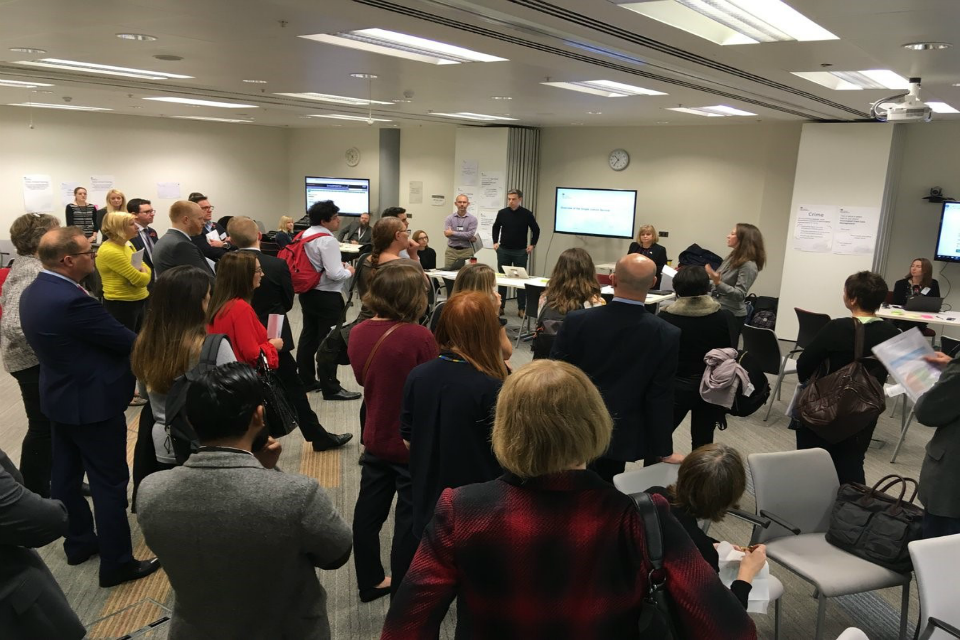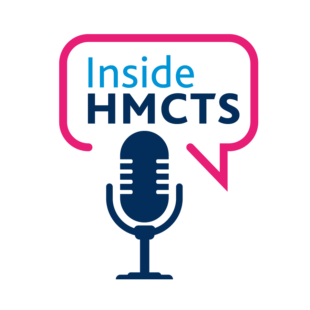[English] - [Cymraeg]
The justice system is for everyone. Even when we’re not using it directly, the fact that it exists is fundamental to our way of life. In this respect, we are all ‘users’ of the justice system.
Putting the people who use our courts and tribunals – all those who want or need to access justice, as well as those of us that rely on it to uphold our rights – at the heart of redesigning services is fundamental to our ambitious £1bn reform programme. Our widely respected justice system has evolved over hundreds of years, but along the way it has increasingly been designed by and for professional court users such as court staff, lawyers and judges, often making it very difficult for the general public to use.

Through our reform programme, we have the opportunity to redress the imbalance in areas where members of the public can benefit most from new ways to access justice or redesigned services. But with over four million cases a year coming in to the courts, how do we capture feedback from members of the public who use (or may need to use) our many services and how do we test redesigned services back with our communities?
One of the ways that we are doing this, as well as listening directly to people who use our services, is through a network of organisations – often from the third sector – who specialise in understanding the needs of particular groups of people or who support them when they come to court. This helps us to listen to and consider the many and varied needs of our public users.
What is a public user?
When we talk about public users, we mean people who interact with the court in relation to their own case in a non-professional capacity. To ensure we hear the voices of those who are most likely to feel the impact of court reforms, we have identified five groups of public users that could be considered particularly significant or vulnerable:
- litigants in person (people who are not represented by a legal professional)
- victims and witnesses
- children and young people
- defendants
- those with equality and inclusion requirements.
For each of these groups we work with a mix of organisations, subject matter experts and people with personal experience of using the justice system to garner the views of people that are like them. It means that we are constantly getting input from our public users and that they continuously inform what we do and how we do it.
How do we work with public users?
For each of the five user groups we run an engagement group. The group is made up of organisations and individuals with similar experiences or characteristics. We use our regular group meetings to discuss, review and collaborate on different aspects of the courts and tribunals reform programme. My team facilitates this. We bring together public users with HMCTS teams to exchange ideas and understand each other’s perspective. Wherever possible, we use this feedback to shape what we do. And even where we can’t make a change as a direct result of public user input (because we must consider a range of other factors including technology, professional user needs, cost and time constraints among other things) this increased understanding and scrutiny invariably improves the quality of our work.
What services have public users helped to design?
Over the past year we have worked with the members of each of our engagement groups on a wide range of engagement activities:
- A court walk-through involving experts from the advice sector, who helped our teams identify elements of coming to court that may cause difficulty to some members of the public.
- A bespoke workshop that focused on how best to take vulnerable user groups into consideration when we are evaluating our reform programme.
- A specific piece of work focusing on the online and paper formats of a service, exploring how to improve engagement and take up amongst all public users.
- An annual event to bring together HMCTS teams with a wider group of public users and talk about the latest progress in redesigned services. Last year 150 people attended to discuss the work of over 25 HMCTS projects.
Over the coming months, I’ll be writing further blogs that will look in more detail at the work of some of our engagement groups, including the people involved and, importantly, the impact that they’re having to improve our services for the people who use them.
Visit GOV.UK to find out more about these groups, who’s a member and what activity they’ve been working on. And if you represent an organisation that you feel could bring a new perspective, you can get in in touch at publicengagement@justice.gov.uk.
[English] - [Cymraeg]
Gwrando ar lais defnyddwyr cyhoeddus wrth inni ail-ddylunio ein gwasanaethau
Mae’r system gyfiawnder yno i bawb. Hyd yn oed pan nad ydym yn ei defnyddio, mae’r ffaith ei bod yn bodoli yn sylfaenol i’n ffordd o fyw. Yn hyn o beth, rydym i gyd yn ‘ddefnyddwyr’ y system gyfiawnder.
Mae rhoi’r bobl sy’n defnyddio ein llysoedd a’n tribiwnlysoedd - pawb sydd eisiau neu sydd angen mynediad at gyfiawnder, ynghyd â’r rhai hynny ohonom sy’n dibynnu arni i gynnal ein hawliau - wrth wraidd ein hymdrechion i ail-ddylunio gwasanaethau fel rhan o’n rhaglen ddiwygio uchelgeisiol sydd werth £1 biliwn. Mae ein system gyfiawnder uchel ei pharch wedi esblygu dros cannoedd o flynyddoedd, ond ar hyd y ffordd mae wedi cael ei hail-ddylunio gan, ac ar gyfer defnyddwyr proffesiynol y llys megis staff y llys, cyfreithwyr a barnwyr, gan yn aml iawn ei gwneud yn anodd iawn i'r cyhoedd ei defnyddio.
Trwy ein rhaglen ddiwygio, mae gennym gyfle i unioni’r anghydbwysedd yn y meysydd hynny lle gall aelodau'r cyhoedd elwa fwyaf ohonynt drwy gael ffyrdd newydd o gael mynediad at gyfiawnder neu wasanaethau sydd wedi’u hail-ddylunio. Ond gyda'r llysoedd yn delio â dros bedair miliwn o achosion bob blwyddyn, sut ydym yn cael adborth gan aelodau'r cyhoedd sy’n defnyddio (neu sydd efallai angen defnyddio) ein gwasanaethau amrywiol a sut ydym yn profi gwasanaethau sydd wedi cael eu hail-ddylunio gyda’r bobl sydd yn byw yn ein cymunedau?
Un o'r ffyrdd yr ydym yn gwneud hyn, yn ogystal â gwrando yn uniongyrchol ar y bobl sy’n defnyddio ein gwasanaethau, yw drwy rwydwaith o sefydliadau - sydd yn aml yn rhan o'r trydydd sector - sy’n arbenigo mewn deall anghenion grwpiau penodol o bobl neu sy’n eu cefnogi pan fyddant yn dod i'r llys. Mae hyn yn ein helpu ni i wrando ar, ac ystyried anghenion amrywiol ein defnyddwyr cyhoeddus.
Beth yw defnyddiwr cyhoeddus?
Pan rydym yn sôn am ddefnyddwyr cyhoeddus, rydym yn golygu pobl sy’n ymwneud â’r llys mewn perthynas â’u hachos eu hunain mewn swyddogaeth nad yw’n broffesiynol. Er mwyn sicrhau ein bod yn clywed lleisiau'r rheini sydd fwyaf tebygol o deimlo effaith y newidiadau i'r llysoedd, rydym wedi adnabod pum grŵp o ddefnyddwyr cyhoeddus y gellid eu hystyried yn eithriadol o arwyddocaol neu’n agored i niwed:
- ymgyfreithwyr drostynt eu hunain (pobl nad ydynt yn cael eu cynrychioli gan weithiwr proffesiynol ym maes y gyfraith)
- dioddefwyr a thystion
- plant a phobl Ifanc
- diffynyddion
- y rhai sydd â gofynion cydraddoldeb a chynhwysiant.
Ar gyfer pob un o'r grwpiau hyn rydym yn gweithio gydag amrywiaeth o sefydliadau, arbenigwyr pwnc a phobl sydd â phrofiad personol o ddefnyddio'r system gyfiawnder i gasglu barn pobl sydd fel nhw. Mae'n golygu ein bod ni'n cael barn ein defnyddwyr cyhoeddus yn gyson a'u bod nhw yn hysbysu'r hyn yr ydym yn ei wneud yn barhaus a sut rydym yn ei wneud.
Sut ydym yn gweithio gyda defnyddwyr cyhoeddus?
Mae gennym grŵp ymgysylltu ar gyfer pob un o'r pum grŵp defnyddwyr. Mae aelodaeth y grŵp yn cynnwys sefydliadau ac unigolion sydd â phrofiadau neu nodweddion tebyg. Rydym yn defnyddio ein cyfarfodydd grŵp rheolaidd i drafod, adolygu a chydweithio ar wahanol agweddau ar raglen diwygio'r llysoedd a'r tribiwnlysoedd, ac mae fy nhîm i yn hwyluso hyn. Rydym yn dod â defnyddwyr cyhoeddus a thimau GLlTEM at ei gilydd i gyfnewid syniadau a deall persbectif ei gilydd. Pryd bynnag y bo modd, rydym yn defnyddio'r adborth hwn i siapio'r hyn a wnawn. A hyd yn oed pan na allwn wneud newid o ganlyniad uniongyrchol i fewnbwn defnyddwyr cyhoeddus (oherwydd mae'n rhaid i ni ystyried ystod o ffactorau eraill gan gynnwys technoleg, anghenion defnyddwyr proffesiynol, cyfyngiadau cost ac amser ymhlith pethau eraill) mae'r ddealltwriaeth a'r craffu cynyddol hwn yn ddieithriad yn gwella ansawdd ein gwaith.
Pa wasanaethau y mae defnyddwyr cyhoeddus wedi helpu i'w dylunio?
Dros y flwyddyn diwethaf rydym wedi gweithio gydag aelodau pob un o'n grwpiau ymgysylltu ar ystod eang o weithgareddau ymgysylltu:
- Taith gerdded drwy’r llys gydag arbenigwyr o'r sector cynghori, a wnaeth helpu ein timau i adnabod elfennau o'r broses o ddod i'r llys a allai achosi anhawster i rai aelodau o'r cyhoedd.
- Gweithdy pwrpasol a oedd yn canolbwyntio ar y ffordd orau i ystyried anghenion defnyddwyr bregus pan ydym yn gwerthuso ein rhaglen ddiwygio.
- Darn penodol o waith yn canolbwyntio ar fformatau ar-lein a phapur gwasanaeth, yn archwilio sut i wella ymgysylltiad a defnydd ymhlith yr holl ddefnyddwyr cyhoeddus.
- Digwyddiad blynyddol i ddod â thimau GLlTEM â grŵp ehangach o ddefnyddwyr cyhoeddus at ei gilydd i siarad am y datblygiadau diweddaraf wrth inni fynd ati i ail-ddylunio ein gwasanaethau. Y llynedd, mynychodd 150 o bobl i drafod gwaith dros 25 o brosiectau GLlTEM.
Dros y misoedd nesaf, byddaf yn ysgrifennu rhagor o flogiau a fydd yn edrych yn fanylach ar waith rhai o'n grwpiau ymgysylltu, gan gynnwys y bobl sy’n aelodau ohonynt ac, yn hollbwysig, yr effaith maent yn ei gael ar wella ein gwasanaethau i'r bobl hynny sy'n eu defnyddio.
Ewch i GOV.UK i ddarganfod mwy am y grwpiau hyn, yr aelodau a beth maent wedi bod yn gweithio arn. Ac os ydych chi'n cynrychioli sefydliad yr ydych chi'n teimlo allai ddod â phersbectif newydd, anfonwch neges e-bost i publicengagement@justice.gov.uk .
